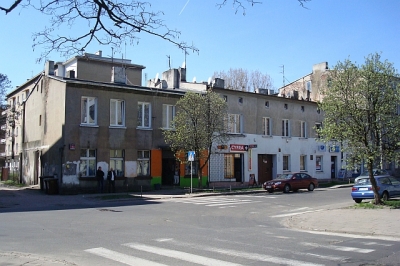This street played a significant role in the history of the Lodz ghetto. Several important institutions were located in the surroundings of Bazarny Rynek, a major marketing area in the ghetto.
 The Economics Department operated at 6 Rybna St. A pharmacy was here as well.
The Economics Department operated at 6 Rybna St. A pharmacy was here as well.
Next door, at 8 Rybna St., there were several departments, including , and, beginning in December 1941, the Displaced Persons Department. The Displaced Persons Department worked with the new deportees, most notably the Jews brought in from regional towns and villages, and those from outside Poland. This unit, which provided valuable advice and necessary information to help the newly-deported, authorized other departments and agencies to get involved as deemed necessary. The Department of Employment for the newcomers was also at this site, and, beginning in May 1942, the Deportation Committee functioned here.
The Deportation Committee prepared transport lists of the deportees from abroad that were to be sent to the death camp at Chelmno-nad-Nerem. Here, one could find out if he or she would remain in the ghetto or be scheduled for deportation to the unknown.
The victims scheduled to be executed in Bazarny Square were also listed here.
 Nearby, at 10/12 Rybna St., was the Housing (Quartering) Department, which moved here from 11 Lutomierska St. A primary school operated out of the building at 15 Rybna St. until the autumn of 1941. When the deportees from outside Poland began to arrive, a group of Düsseldorf Jews was housed here. Beginning in May 1942, a slippers department was located there.
Nearby, at 10/12 Rybna St., was the Housing (Quartering) Department, which moved here from 11 Lutomierska St. A primary school operated out of the building at 15 Rybna St. until the autumn of 1941. When the deportees from outside Poland began to arrive, a group of Düsseldorf Jews was housed here. Beginning in May 1942, a slippers department was located there.
During the first two years of the ghetto, a school was also at 21 Rybna St.
In October 1941, the Düsseldorf Jews began to live here as well. In June 1942, the Jewish deportees from the small regional town of Ozorkow were settled here.
Yesterday... visited us and told us how brilliantly the ghetto offices are functioning. He said he went to the economics department with a request for three brooms. When he came, he turned to the janitor who directed him to some manager. The manager sent him to Room No.2, where eight clerks were sitting; each of them checked if the request is not forged. From Room No.2, they sent him to Room No.5, where there were 12 clerks who did exactly the same thing. Then he was directed to Warehouse No.3, and from warehouse No.3 to Warehouse No.
1, and from No.1 to No.2, and in another warehouse he was given three brooms with five hairs each.
Jehuda Lubiński, Diary, February 16, 1941, p. 389.
The first day of deportations. The committee located at Fischstrasse [Rybna Street}, has completed the lists, working day and night. Every day a thousand people lands in the police prison, which serves as an assembly point for all transports. The paupers from Koeln and Düsseldorf are moving along the streets: they are the first to be deported.
Oskar Singer, Quickly Walking Through the Ghetto, May 4, 1942., p. 27
The claims committee works day and night; punctually at 8 a.m. crowds of customers fill the courtyard of the building, where the office is located. At this time a clerk reads out the names of those released or postponed from deportation. The crowd listens to it in the most nervous atmosphere. It makes an impression as if people were waiting for a pardon or a death sentence. Everyone's reaction to their name read out is tears of joy or a terrible despair. Without any exaggeration, the morning hours in the courtyard at 8 Rybna St. are filled with deep tragedy.
The Chronicle of the Lodz Ghetto, May 9-11, 1942, Vol. 2, p. 525.
The Displaced Persons Department, organized on Rybna Street, will be liquidated on January 1, 1943. This Department became redundant since no new resettlements to the ghetto are planned. This office played a great role in October and November 1941, when 20,000 Western European Jews arrived in the ghetto, and when thousands of Jews from the provincial towns of Warthegau [the regional area] were settled in the ghetto.
The Chronicle of the Lodz Ghetto, December 6-7,1942, Vol. 2, p. 421

 Home
Home
